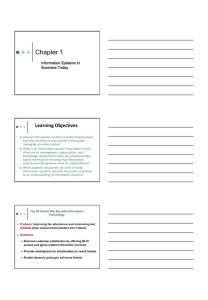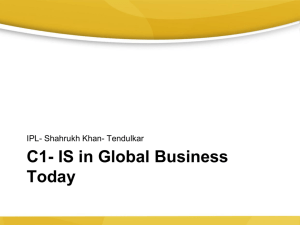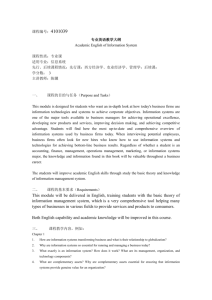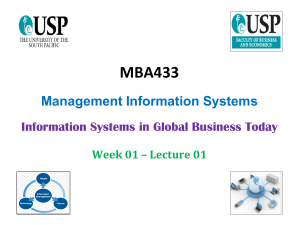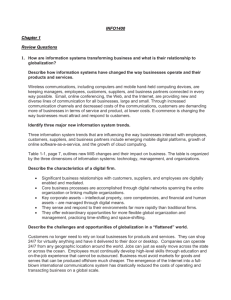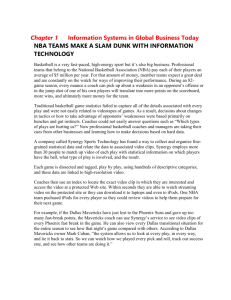File - Md. Mahbubul Alam, PhD
advertisement
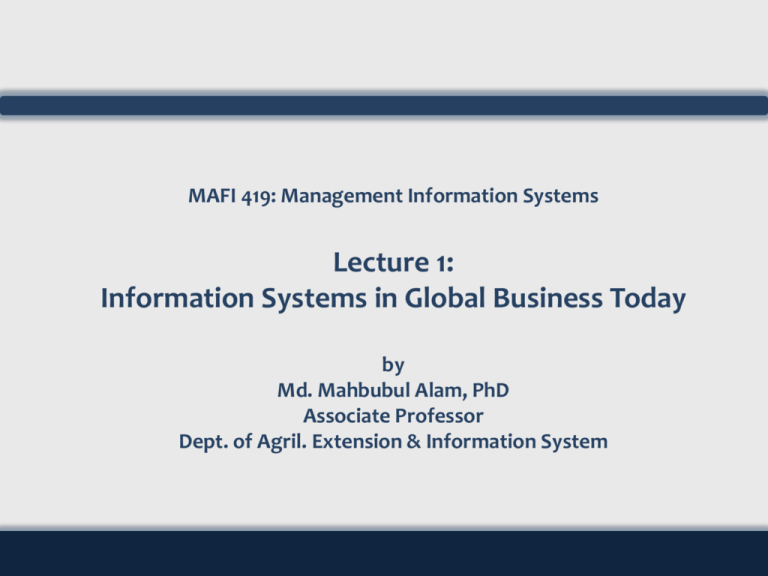
MAFI 419: Management Information Systems Lecture 1: Information Systems in Global Business Today by Md. Mahbubul Alam, PhD Associate Professor Dept. of Agril. Extension & Information System Learning Objectives • Understanding the effects of information systems on business and their relationship to globalization. • Explain why information systems are so essential in business today. • Define an information system and describe its management, organization and technology components. • Define complementary assets and explain how they ensure that information systems provide genuine value to an organization. • Describe the different academic disciplines used to study information systems and explain how each contributes to our understanding of them. • Explain what is meant by a Sociotechnical systems perspective. The Role of IS in Business Today (1) • How information systems are transforming business – Increase in wireless technology use, Web sites – Increased business use of Web 2.0 technologies – Cloud computing, mobile digital platform allow more distributed work, decision-making, & collaboration • Globalization opportunities – Internet has drastically reduced costs of operating on global scale – Presents both challenges and opportunities The Role of IS in Business Today (2) IT Capital Investment “MIS is using technology to create business value.” Internet and global communications had greatly reduced the economic and cultural advantages of developed countries. What’s New in MIS? (1) Change in Technology Business Impact • Cloud computing • A flexible collection of computers on the Internet. • Perform tasks traditionally performed on corporate computers. •e.g., Dropbox, SkyDrive • Growth in software as a service (SaaS) • Major business applications are now delivered online as an Internet service. • Mobile digital platform • iTunes (Apple) store • Google Play (Android) • Ipad • Smart Phone What’s New in MIS? (2) Change in Management Business Impact • Online collaboration & SNS software ( to improve coordination, collaboration & knowledge sharing) • Google Apps, Google Sites, Microsoft’s Windows SharePoint Services, IBM’s Lotus Connections • used by over 100 million business professionals • for managing blogs, project management, online meeting, personal profiles, online communities. Business Intelligence (BI) • Data analytics, provide real time performance information • Efficient decision making Virtual Meeting Proliferate • Telepresence video conferencing, Skype • Web conferencing • Reduced travel time, cost • Improved collaboration & decision making What’s New in MIS? (3) Change in Organizations Business Impact • Web 2.0 • Enable employees to interact as online communities • Blogs, wikis, e-mail, and instant messaging services. • Facebook and MySpace create new opportunities for business to collaborate with customers and vendors. • Telework • Virtual Office/remote work program • The Internet and mobile handheld devices, such as netbooks, iPads, iPhones, and BlackBerrys • Co-creation of business value • Shifting Business Value • internal sources to networks of suppliers and collaboration with customers. • Supply chains and product development are more global and collaborative. • Customers help firms define new products and services. Q1. How do business firms seek success from digitalization and/or globalization? In the emerging, the fully digital firm • Significant business relationships are digitally enabled and mediated • Core business processes are accomplished through digital networks • Key corporate assets are managed digitally • Digital firms offer greater flexibility in organization and management • Firms are now more keen to be benefitted from globalization – Time shifting, space shifting – e.g., Accenture, Microsoft, Dell • Digital firms are ideally suited for global operations by allowing business to be conducted at any time and any place Interdependence between Organizations & IT In contemporary systems there is a growing interdependence between a firm’s information systems and its business capabilities. Changes in strategy, rules, and business processes increasingly require changes in hardware, software, databases, and telecommunications. Often, what the organization would like to do depends on what its systems will permit it to do. Why Firms Invest in IS? • To achieve six strategic business objectives – – – – – – Operational excellence New products, services, & business models Customer & supplier intimacy Improved decision making Competitive advantage Survival Operational excellence • Improvement of efficiency to attain higher profitability • Information systems, technology an important tool in achieving greater efficiency and productivity • Wal-Mart’s RetailLink system links suppliers to stores for superior replenishment system • Q. Does operational excellence make a difference for customer purchasing? New products, services, & business models • Business model – describes how company produces, delivers, and sells product or service • Information systems and technology a major enabling tool for new products, services, business models – Apple’s iPod, iTunes, and iPhone, Netflix’s Internet-based DVD rentals • Can you name a few? Customer & supplier intimacy • Serving customers well leads to customers returning, which raises revenues and profits – High-end hotels that use computers to track customer preferences and use to monitor and customize environment • Intimacy with suppliers allows them to provide vital inputs, which lowers costs – J.C.Penney’s information system which links sales records to contract manufacturer Improved decision making Without accurate information: •Overproduction •underproduction of goods and services • Misallocation of resources •Poor response times, Poor outcomes (raise costs, lose customers) Managers must use forecasts, best guesses, luck Example •Verizon’s Web-based digital dashboard to provide managers with realtime data on customer complaints, network performance, line outages, etc. Competitive advantage • Delivering better performance • Charging less for superior products • Responding to customers and suppliers in real time – Apple, Walmart, etc. • One way to achieve competitive advantage is to achieve the previous four objectives Survival • Industry-level changes – introduction of ATMs • Governmental regulations requiring record-keeping – Toxic Substances Control Act, Sarbanes-Oxley Act Concept of MIS • Information system – Set of interrelated components – Collect, process, store & distribute information – Support decision making, coordination, & control Concept of MIS (Cont’d) • Select technology • Monitoring cost • Revise job & work processes Business challenges Management Organization Technology • Deploy wireless network • Deploy Skype • Deploy internet and PCs • Complex environment • Labor condition • Global economic condition Information Systems • Expedite communication • Track work status in real time Business solutions • Increase efficiency • Lower costs Information Vs. Data • Information – is a processed data that are represented facts, and thereby assist decisionmaking process. – meaningful facts – e.g., total unit sales or total sales revenue from a product • Data – raw fact that represents events occurring in an organization – e.g., customer record, data at the sales counter What is a system? • System • A system is a set of elements which are joined together to achieve a common objective. • Elements are interdependent and interrelated. • Three elements i. Input: captures or collects data from within the organization or from its external environment. ii. Process: converts raw input into a meaningful form. iii. Output: transfers the processed information to the users. Functions of an IS An information system contains information about an organization and its surrounding environment. Three basic activities—input, processing, and output— produce the information organizations need. Feedback is output returned to appropriate people or activities in the organization to evaluate and refine the input. Environmental actors, such as customers, suppliers, competitors, stockholders, and regulatory agencies, interact with the organization and its information systems. Computer/ computer software Vs. IS • Computer and software are the technical foundation and tools. • Similar to the material and tools used to build a house. Information Systems Are More Than Computers Using information systems effectively requires an understanding of the organization, management, and information technology shaping the systems. An information system creates value for the firm as an organizational and management solution to challenges posed by the environment. Technology dimension of IS • Computer hardware and software – Hardware: processor, memory, hard disk, etc. – Software: set of computer programs that controls computer hardware • Data management technology • Networking and telecommunications technology (Networks) – Networks, the Internet, intranets and extranets, World Wide Web, LAN • IT infrastructure: provides platform that system is built on Organizational dimensions • Business organizations are hierarchies consisting of three principle levels. Top Management • Three levels – Top management – Middle management Middle Management • Scientists & knowledge workers – Operational management • Production & service workers • Data workers Operational Management Management dimension of IS • Managers set organizational strategy for responding to business challenges • In addition, managers must act creatively – Creation of new products and services – Occasionally re-creating the organization Business perspective on IS • Information system is instrument for creating value • Investments in information technology will result in superior returns: – Productivity increases – Revenue increases – Superior long-term strategic positioning • However, investing in information technology does not guarantee good returns • Considerable variation in the returns firms receive from systems investments • Good IT but Bad Management! • Factors: – Adopting the right business model – Investing in complementary assets (organizational and management capital) Complementary assets • Assets required to derive value from a primary investment – Firms supporting technology investments with investment in complementary assets receive superior returns – E.g.: invest in technology and the people to make it work properly • Organizational investments, e.g. – Appropriate business model – Efficient business processes • Managerial investments, e.g. – Incentives for management innovation – Teamwork and collaborative work environments • Social investments, e.g. – The Internet and telecommunications infrastructure – Technology standards Contemporary Approaches to IS Contemporary approaches to IS • Technical approach – Emphasizes mathematically based models – Computer science, management science, operations research • Behavioral approach – Behavioral issues (strategic business integration, implementation, etc.) – Psychology, economics, sociology A Sociotechnical Perspective on Information Systems •Performance is achieved by jointly optimizing both social and technical systems. •In a sociotechnical perspective, the performance of a system is optimized when both the technology and the organization mutually adjust to one another until a satisfactory fit is obtained. IS Opportunities & Challenges • • • • • • • • • Opportunities Increase worker productivity Enhance decision making Improve team collaboration Create business partnerships and alliances Enhance global competitiveness Support corporate strategy Improve quality of goods and services Rapidly changing technology • • • • • • • Challenges: Workforce downsizing Information overload Employee mistrust Difficult to build Security breaches Rapidly changing technology
